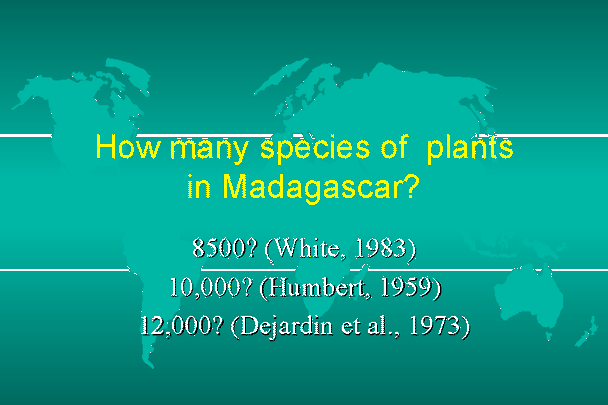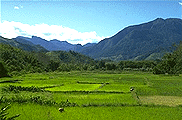

Rice paddies at Manantenina, looking north to Mt. Beondroka in the Marojejy Strict Nature Reserve
The flora and vegetation of Madagascar have attracted the interest of botanists for well over a century, and have captured the imagination of naturalists from throughout the world. This island nation, located off the southeastern coast of Africa, is widely regarded as one of the world's most fascinating centers of plant diversity and endemism. It is also home to some of the most highly threatened habitats on Earth, and increasingly is being recognized as a priority area for conservation activities. Madagascar (ca. 587,000 km) has a remarkable array of vegetation types, ranging from perhumid tropical forests, where average annual precipitation exceeds 3,500 mm, to arid semi-deserts that receive less than 350 mm of rainfall per year (Koechlin et al., 1974).

The native flora is also exceptionally rich, although no one knows with certainty how many plants occur on Madagascar, and recent estimates range from 8,500 species (White, 1983) to 10,000 (Humbert, 1959; Phillipson, 1994) or even 12,000 species (Dejardin et al., 1973), of which anywhere from perhaps 70% to 80% or more are endemic (Humbert, 1959). By comparison, perhaps 30-35,000 species occur in all of tropical Africa including the Sahel (Brenan, 1978; Morat and Lowry, 1993), which covers almost 35 times as much area. The evolution of Madagascar's flora and vegetation reflects the island's geological and tectonic history, and its present position in the southwestern Indian Ocean (Krause, in press; Schatz, in press). Madagascar separated from continental Africa along the southern Somalia-Kenya-Tanzania coastline in the Jurassic, ~ 165 million years before present (MYBP), and reached its current position in the early Cretaceous, ca. 121 MYBP (Rabinowitz et al., 1983; Coffin and Rabinowitz, 1987), just prior to the initial major diversification of angiosperms (Friis et al., 1987, and references therein). The subsequent breakup of Madagascar and Greater India occurred in the late Cretaceous, ~ 88 MYBP (Storey et al., 1995). Regarded by many as a microcontinent (e.g., Paulian, 1984), Madagascar stands in sharp contrast to other islands of the region (Comores, Réunion, and Mauritius), which are of recent volcanic origin, and consequently have floras that are less rich and are markedly disharmonic. The affinities of the Malagasy flora are, not surprisingly, strongest with Africa, reflecting its relative proximity, and are most evident in the seasonal western and southern parts of the island (Leroy, 1978; Phillipson, in press). Clear relationships are also evident with Asia (primarily India, Sri Lanka, and the Malesian region), especially in the moister eastern part of Madagascar (Perrier de la Bâthie, 1936; Dejardin et al., 1973; Koechlin et al., 1974; Leroy, 1978; Schatz, in press).